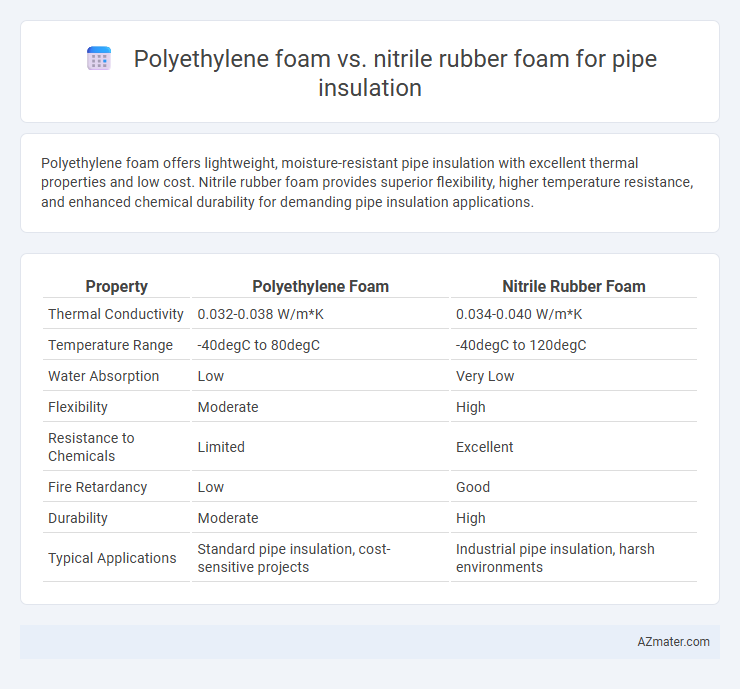Polyethylene foam offers lightweight, moisture-resistant pipe insulation with excellent thermal properties and low cost. Nitrile rubber foam provides superior flexibility, higher temperature resistance, and enhanced chemical durability for demanding pipe insulation applications.
Table of Comparison
| Property | Polyethylene Foam | Nitrile Rubber Foam |
|---|---|---|
| Thermal Conductivity | 0.032-0.038 W/m*K | 0.034-0.040 W/m*K |
| Temperature Range | -40degC to 80degC | -40degC to 120degC |
| Water Absorption | Low | Very Low |
| Flexibility | Moderate | High |
| Resistance to Chemicals | Limited | Excellent |
| Fire Retardancy | Low | Good |
| Durability | Moderate | High |
| Typical Applications | Standard pipe insulation, cost-sensitive projects | Industrial pipe insulation, harsh environments |
Introduction to Pipe Insulation Materials
Polyethylene foam and nitrile rubber foam are two of the most popular materials used for pipe insulation due to their excellent thermal resistance and durability. Polyethylene foam offers lightweight, closed-cell structure, and high moisture resistance, making it ideal for preventing heat loss and condensation on pipes in various industrial and residential applications. Nitrile rubber foam provides superior flexibility, excellent thermal insulation, and resistance to oils and chemicals, which is particularly beneficial in HVAC systems and environments requiring enhanced mechanical strength and aging resistance.
Overview of Polyethylene Foam
Polyethylene foam is a lightweight, closed-cell insulation material widely used for pipe insulation due to its excellent thermal resistance and moisture barrier properties. Its low thermal conductivity, typically around 0.033 W/m*K, helps reduce heat loss and prevent condensation on pipes. Polyethylene foam also offers chemical resistance, durability, and flexibility, making it ideal for HVAC systems and plumbing applications where corrosion resistance and ease of installation are essential.
Overview of Nitrile Rubber Foam
Nitrile rubber foam is a closed-cell elastomeric insulation material known for its excellent thermal resistance, flexibility, and outstanding moisture and chemical resistance, making it ideal for pipe insulation in industrial and commercial applications. Compared to polyethylene foam, nitrile rubber foam offers superior durability and better performance in high-temperature and high-humidity environments, enhancing energy efficiency and preventing condensation. Its inherent resistance to oils, fuels, and ozone extends the lifespan of insulated pipes, reducing maintenance costs significantly.
Thermal Insulation Performance Comparison
Polyethylene foam exhibits superior thermal insulation performance for pipe insulation due to its closed-cell structure, which provides low thermal conductivity values ranging from 0.034 to 0.040 W/m*K, effectively reducing heat transfer. Nitrile rubber foam offers enhanced flexibility and excellent resistance to oils and chemicals but generally has a slightly higher thermal conductivity, approximately 0.040 to 0.045 W/m*K, resulting in marginally less efficient insulation. Selecting polyethylene foam is ideal for applications requiring maximum thermal efficiency, while nitrile rubber foam suits environments demanding durability against mechanical stress and chemical exposure.
Moisture Resistance and Water Absorption
Polyethylene foam exhibits superior moisture resistance with very low water absorption rates, typically below 1%, making it highly effective in preventing condensation and maintaining pipe insulation integrity. Nitrile rubber foam offers moderate moisture resistance but tends to absorb more water due to its open-cell structure, which can compromise thermal performance over time. Choosing polyethylene foam ensures better protection against moisture-related damage in pipe insulation applications.
Durability and Longevity
Polyethylene foam offers excellent durability with high resistance to moisture, chemicals, and physical impacts, maintaining insulation performance over extended periods. Nitrile rubber foam provides superior aging resistance and flexibility, with strong resistance to oils, ozone, and UV exposure, enhancing its longevity in harsh environments. Both materials perform well in pipe insulation applications, but nitrile rubber foam typically delivers longer service life under demanding conditions.
Fire Resistance and Safety Ratings
Nitrile rubber foam offers superior fire resistance compared to polyethylene foam, with a higher limiting oxygen index (LOI) typically above 30%, indicating better non-flammability and slower combustion rates. Polyethylene foam generally has lower fire safety ratings, often classified as Class E or lower under EN 13501-1, whereas nitrile rubber foam insulation frequently achieves Class B-s1,d0, reflecting enhanced smoke and flame retardancy. For pipe insulation applications demanding rigorous fire safety standards, nitrile rubber foam provides a more reliable barrier against flame spread and toxic smoke emissions.
Installation and Flexibility
Polyethylene foam offers superior flexibility and ease of installation due to its lightweight structure and closed-cell composition, which allows it to conform smoothly around pipes and fittings. Nitrile rubber foam, while slightly denser, provides excellent elasticity and durability, enabling tighter sealing in complex piping systems but may require additional cutting or fitting tools during installation. Both materials ensure efficient thermal insulation, but polyethylene foam's pliability makes it preferable for quick, straightforward installations on varied pipe diameters.
Cost Analysis and Economic Factors
Polyethylene foam provides a cost-effective solution for pipe insulation with lower material and installation expenses compared to nitrile rubber foam, making it ideal for large-scale projects with tight budgets. Nitrile rubber foam, while more expensive initially, offers superior durability and chemical resistance, potentially reducing long-term maintenance and replacement costs. Economic factors such as lifecycle cost, environmental conditions, and energy savings influence the overall value proposition between the two insulation materials.
Application Suitability: Choosing the Right Material
Polyethylene foam offers excellent moisture resistance and thermal insulation, making it ideal for indoor pipe insulation in dry, controlled environments. Nitrile rubber foam provides superior flexibility, chemical resistance, and performance in extreme temperatures, suiting it for industrial applications and outdoor pipe insulation. Selecting the right material depends on environmental exposure, temperature range, and specific insulation requirements to ensure durability and efficiency.

Infographic: Polyethylene foam vs Nitrile rubber foam for Pipe insulation
 azmater.com
azmater.com